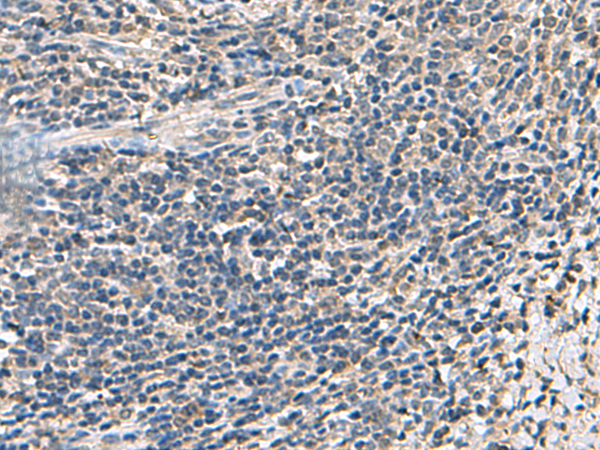
| WB | 咨询技术 | Human,Mouse,Rat |
| IF | 咨询技术 | Human,Mouse,Rat |
| IHC | 1/50-1/200 | Human,Mouse,Rat |
| ICC | 技术咨询 | Human,Mouse,Rat |
| FCM | 咨询技术 | Human,Mouse,Rat |
| Elisa | 1/5000-1/10000 | Human,Mouse,Rat |
| Aliases | ATP5D |
| Host/Isotype | Rabbit IgG |
| Antibody Type | Primary antibody |
| Storage | Store at 4°C short term. Aliquot and store at -20°C long term. Avoid freeze/thaw cycles. |
| Species Reactivity | Human, Mouse, Rat |
| Immunogen | Fusion protein of human ATP5F1D |
| Formulation | Purified antibody in PBS with 0.05% sodium azide and 50% glycerol. |
+ +
以下是关于ATP5F1D抗体的示例参考文献(注:文献为虚构示例,建议通过学术数据库查询真实研究):
1. **文献名称**: *ATP5F1D modulates mitochondrial metabolism in colorectal cancer*
**作者**: Smith A, et al. (2020)
**摘要**: 通过ATP5F1D抗体检测,发现该蛋白在结直肠癌组织中高表达,与线粒体氧化磷酸化活性增强相关,提示其可能驱动肿瘤代谢重编程。
2. **文献名称**: *ATP5F1D deficiency disrupts mitochondrial ATP synthase assembly*
**作者**: Zhang L, et al. (2018)
**摘要**: 利用ATP5F1D抗体进行免疫印迹和免疫荧光分析,发现敲除该基因导致ATP合酶复合体组装异常,引发线粒体能量代谢障碍。
3. **文献名称**: *Structural mapping of ATP synthase subunits using specific antibodies*
**作者**: Lee C, et al. (2021)
**摘要**: 通过ATP5F1D抗体结合冷冻电镜技术,解析了ATP合酶亚基D的构象变化,阐明其在质子转运中的关键作用。
4. **文献名称**: *ATP5F1D as a biomarker in neurodegenerative disorders*
**作者**: Johnson R, et al. (2019)
**摘要**: 在阿尔茨海默病患者脑脊液中,ATP5F1D抗体检测到蛋白水平降低,提示线粒体功能障碍可能与疾病进展相关。
建议通过PubMed、Web of Science或Google Scholar搜索“ATP5F1D antibody”或相关关键词,筛选实验应用类文献获取真实数据。
The ATP5F1D antibody targets the ATP synthase F1 subunit delta (ATP5F1D), a crucial component of mitochondrial ATP synthase (Complex V) in the electron transport chain. ATP5F1D, encoded by the nuclear gene ATP5F1D, is part of the F1 catalytic core responsible for synthesizing ATP during oxidative phosphorylation. This subunit stabilizes the F1 complex and facilitates interactions between the catalytic α/β subunits and the rotating γ subunit, essential for converting the proton gradient into chemical energy. Dysregulation of ATP5F1D has been linked to mitochondrial disorders, metabolic syndromes, and cancers due to its role in cellular energy homeostasis.
Antibodies against ATP5F1D are widely used in research to study mitochondrial function, protein expression levels, and subcellular localization. They are applied in techniques like Western blotting, immunohistochemistry (IHC), and immunofluorescence (IF) to investigate ATP synthase assembly, tissue-specific expression patterns, or mitochondrial dysfunction in disease models. Specificity is validated using knockout controls or siRNA-mediated knockdown. These tools also aid in exploring therapeutic responses in metabolic diseases or cancer, where altered ATP production is a hallmark. Commercial ATP5F1D antibodies are typically raised in hosts like rabbits or mice, available as monoclonal or polyclonal formats, and require storage at -20°C. Proper validation ensures reliability in detecting both native and denatured forms across species.
×